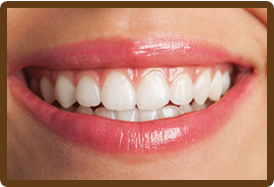ENDODONTICS
Endodontics is a specialized branch of dentistry that deals with the complex structures found inside the teeth. The Greek word “Endodontics” literally means “inside the tooth,” and relates to the tooth pulp, tissues, nerves and blood vessels. Endodontists receive additional dental training after completing dental school to enable them to perform both complex and simple procedures, including root canal therapy. Dr. Trujillo can help determine if a specialist is needed for this treatment or if it can be done in our office.
Historically, a tooth with a diseased nerve would be removed immediately, but endodontists are now able to save the natural tooth in most cases. Generally, extracting the inner tooth structures, then sealing the resulting gap with a filling and crown restores health and functionality to damaged teeth.
Signs and symptoms of endodontic problems:
- Inflammation and tenderness in the gums.
- Teeth that are sensitive to hot and cold foods.
- Tenderness when chewing and biting.
- Tooth discoloration.
- Unexplained pain in the nearby lymph nodes.
Reasons for endodontic treatment
Endodontic treatment (or root canal therapy) is performed to save the natural tooth. In spite of the many advanced restorations available, most dentists (including Dr. Trujillo) agree that there is no substitute for healthy, natural teeth.
Here are some of the main causes of inner tooth damage:
Bacterial infections – Oral bacteria is the most common cause of endodontic problems. Bacteria invade the tooth pulp through tiny fissures in the teeth caused by tooth decay or injury. The resulting inflammation and bacterial infection jeopardize the affected tooth and may cause an abscess to form.
Fractures and chips – When a large part of the surface or crown of the tooth has become completely detached, root canal therapy may be required. The removal of the crown portion leaves the pulp exposed, which can be debilitating, painful and problematic.
Injuries – Injuries to the teeth can be caused by a direct or indirect blow to the mouth/facial area. Some injuries cause a tooth to become luxated, or dislodged, from its socket. Root canal therapy is often needed after the endodontist has successfully stabilized the injured tooth.
Removals – If a tooth has been knocked clean out of the socket, it is important to rinse it and place it back into the socket as quickly as possible. If this is impossible, place the tooth in special dental solution (available at pharmacies) or in milk. These steps will keep the inner mechanisms of the tooth moist and alive while emergency dental treatment is sought. The tooth will be affixed in its socket using a special splint, and the endodontist will then perform root canal therapy to save the tooth.
What does an endodontic procedure invlove?
Root canal therapy usually takes between one and three visits to complete. Complete X-rays of the teeth will be taken and examined before the treatment begins.
Initially, a local anesthetic will be administered, and a dental dam (protective sheet) will be placed to ensure that the surgical area remains free of saliva during the treatment. An opening will be created in the surface of the tooth, and the pulp will be completely removed using small handheld instruments.
The space will now be shaped, cleaned and filled with gutta-percha. Gutta-percha is a biocompatible material that is somewhat similar to rubber. Cement will be applied on top to ensure that the root canals are completely sealed off. Usually, a temporary filling will be placed to restore functionality to the tooth prior to the permanent restoration procedure. During the final visit, a permanent restoration or crown will be placed.
If you have questions or concerns about endodontic procedures, call us at (575)526-0888.
Cracked and fractured teeth are common dental problems. As people retain their natural teeth longer (due to advances in dental technology), the likelihood of cracked teeth increases. There are many reasons why teeth may crack, for example, biting on hard objects, trauma, grinding and clenching of teeth. All of these behaviors place the teeth under extra strain and render them more susceptible to cracking.
When tooth enamel is cracked, pain can become momentarily debilitating. When no pressure is exerted on the crack there may be no discomfort. However, as the cracked tooth performs a biting action, the crack widens. The pulp and inner workings of the tooth then become exposed, and painful irritation occurs. As pressure is released again, the two parts of the crack fuse back together, and pain subsides. If left untreated, the pulp becomes irreversibly damaged and constantly painful. The resulting pulp infection can affect the bone and soft tissue surrounding the tooth.
Symptoms of a cracked tooth may include:
- Unexplained pain when eating.
- Sensitivity to warm and cold foods.
- Pain with no obvious cause.
- Difficulty pinpointing the location of the pain.
What kind of cracks can affect the teeth?
There are many ways in which a tooth can be cracked. The specific type of crack will determine what type of treatment is viable. In many cases, if the crack is not too deep, root canal therapy can be performed and the natural tooth can remain in the mouth. In other situations, the tooth is too badly damaged and requires extraction.
Here is a brief overview of some of the most common types of cracks:
Crazes – These are generally tiny vertical cracks that do not place the teeth in danger. These scratches on the surface of the teeth are considered by most dentists to be a normal part of the tooth anatomy. A craze rarely requires treatment for health reasons, but a wide variety of cosmetic treatments can be performed to reduce the negative aesthetic impact.
Oblique supragingival cracks – These cracks only affect the crown of the tooth and do not extend below the gum line. Usually, the affected part of the tooth will eventually break off. Little pain will result, because the tooth pulp (that contains the nerves and vessels) will remain unaffected.
Oblique subgingival cracks – These cracks extend beyond the gum line, and often beyond where the jawbone begins. When a piece breaks off, it will usually remain attached until the dentist removes it. Oblique subgingival cracks are painful and may require a combination of periodontal surgery (to expose the crown), and endodontic treatment to place a crown or other restorative device.
Vertical furcation cracks – These cracks occur when the roots of the tooth separate. This type of crack almost always affects the nerve of the tooth. Because the tooth will not generally separate completely, root canal therapy and a crown can usually save the tooth.
Oblique root cracks – These cracks tend not to affect the surface of the tooth at all. In fact, the damage is only apparent below the gum line and usually below the jawbone. Root canal therapy may be possible; depending on how close the fracture is to the tooth surface. However, extraction is almost always the only option after sustaining this classification of fracture.
Vertical apical root cracks – These cracks occur at the apex (tip of the root). Though the tooth does not require extraction from a dental perspective, many patients request an extraction because of the high degree of pain. Root canal therapy alleviates the discomfort for a while, but most often, teeth affected by such cracks are eventually extracted.
How are cracks in the teeth treated?
There are many different types of cracked teeth. Some can only be exposed using X-ray machines, while others are clearly visible to the naked eye. In cases where the tooth root is affected, root canal therapy is the most viable treatment option. The pulp, nerves and vessels of the tooth will be removed, and the resulting space will be filled with gutta-percha. A crown or filling will be added to stabilize the tooth and it will continue to function as normal.
When the crack is too severe for the tooth to be saved, Dr. Trujillo will perform an extraction. There are a number of restorative options in this case, such as bridges, dental implants and partial dentures. All of these structures can restore biting, chewing and speaking functions.
Call (575)526-0888 to schedule a consultation with Dr. Trujillo, she would be happy to answer your questions!
Root amputation is a specialized dental procedure, whereby one root is removed from a multi-root tooth. The tooth is then stabilized and rendered fully functional with a crown or filling. The multi-root teeth best suited to the root amputation procedure are the molars at the back of the mouth. These large flat teeth have either two or three roots depending on whether they are situated on the upper or lower jaw.
The general purpose of root amputation is to save an injured or diseased tooth from extraction. Dr. Trujillo and most dentists agree that there is no better alternative than retaining a healthy natural tooth, and the root amputation procedure makes this possible.
When is root amputation necessary?
It is important to note that root amputation can only be performed on an otherwise healthy tooth. Even in the case of a “key” tooth, extraction will be performed if the tooth is diseased, badly fractured or otherwise injured. Suitable teeth for root amputation have a healthy tooth surface, strong bone support and healthy underlying gums.
There are several problems that may lead to root amputation including:
- Broken, fractured or injured teeth and roots.
- Embedded bacteria within the structure of the root.
- Severe bone loss in a concentrated area due to periodontitis.
- Tooth decay in a concentrated area of the tooth.
What does root amputation involve?
Prior to root amputation, it is necessary to perform root canal treatment. The amputation itself involves cutting deep into the tooth where blood vessels and nerves are located. For this reason, the pulp of the tooth including these vessels and nerves needs to be removed before resectioning the roots. The root canal and amputation treatments will be performed under local anesthetic.
During the root amputation procedure, a small incision will be created in the gum to fully expose the roots of the affected tooth. The root will be sectioned off from the rest of the tooth and then removed. To kill any remaining bacteria, the whole area will be cleansed with saline solution, and then sutures (stitches) will be applied to seal the incision.
Finally, a temporary crown or filling will be placed to secure the tooth. Depending on the specific situation, painkillers, antibiotics and a medicated anti-microbial mouthwash may be prescribed. In 7-10 days, the stitches will be removed and the gum will have healed. Arrangements can now be made to place the permanent crown or filling.
If you have any questions or concerns about root amputation, please call our office at (575)526-0888 to schedule a consultation with Dr. Trujillo.
In rare cases, root canal therapy fails to work as expected. The treated tooth might not heal properly or a patient might experience post-surgical complications that jeopardize the tooth. Root canal retreatment involves removal of the previous packing material, the cleansing of the root canals, and the re-packing and restoration of the tooth. In short, root canal retreatment is almost identical to the original procedure, aside from the structural removal. The success rate for a root canal retreatment is approximately 75%.
Root canal treatments and retreatments are sometimes a better alternative than extraction. If a tooth has good bone support, a solid surface and healthy gums beneath it, it stands a good chance of being saved.
Why is root canal retreatment required?
Though the prospect of more endodontic surgery might not be pleasant, root canal retreatment is fairly simple. In general, the whole treatment can be completed in 1-3 visits.
There are a number of reasons why root canal therapy unexpectedly fails, including:
- Cracked crown leaking filling material.
- Curved or narrow canals not treated during the original procedure.
- Delay in the placement of restorative devices following the procedure.
- New decay to the tooth.
- New fracture in the treated tooth.
- Saliva entering the restorative structure.
- Undetected complex canal structures.
Root canal therapy is needed when the nerve of a tooth is affected by decay or infection. In order to save the tooth, the pulp (the living tissue inside the tooth), nerves, bacteria, and any decay are removed and the resulting space is filled with special, medicated, dental materials, which restore the tooth to its full function.
Having a root canal done on a tooth is the treatment of choice to save a tooth that otherwise would die and have to be removed. Many patients believe that removing a tooth that has problems is the solution, but what is not realized is that extracting (pulling) a tooth will ultimately be more costly and cause significant problems for adjacent teeth.
Root canal treatment is highly successful and usually lasts a lifetime, although on occasion, a tooth will have to be retreated due to new infections.
Signs and symptoms for possible root canal therapy:
- An abscess (or pimple) on the gums.
- Sensitivity to hot and cold.
- Severe toothache pain.
- Sometimes no symptoms are present.
- Swelling and/or tenderness.
Reasons for root canal therapy:
- Decay has reached the tooth pulp (the living tissue inside the tooth).
- Infection or abscess have developed inside the tooth or at the root tip.
- Injury or trauma to the tooth.
What does root canal therapy involve?
A root canal procedure requires one or more appointments and can be performed by Dr. Trujillo or an endodontist (a root canal specialist).
While the tooth is numb, a rubber dam (a sheet of rubber) will be placed around the tooth to keep it dry and free of saliva. An access opening is made on top of the tooth and a series of root canal files are placed into the opening, one at a time, removing the pulp, nerve tissue, and bacteria. If tooth decay is present, it will also be removed with special dental instruments.
Once the tooth is thoroughly cleaned, it will be sealed with either a permanent filling or, if additional appointments are needed, a temporary filling will be placed.
At the next appointment, usually a week later, the roots and the inside cavity of the tooth will be filled and sealed with special dental materials. A filling will be placed to cover the opening on top of the tooth. In addition, all teeth that have root canal treatment should have a crown (cap) placed. This will protect the tooth and prevent it from breaking, and restore it to its full function.
After treatment, your tooth may still be sensitive, but this will subside as the inflammation diminishes and the tooth has healed.
Dr. Trujillo will provide care instructions after each appointment. Good oral hygiene practices and regular dental visits will aid in the life of your root canal treatment.















